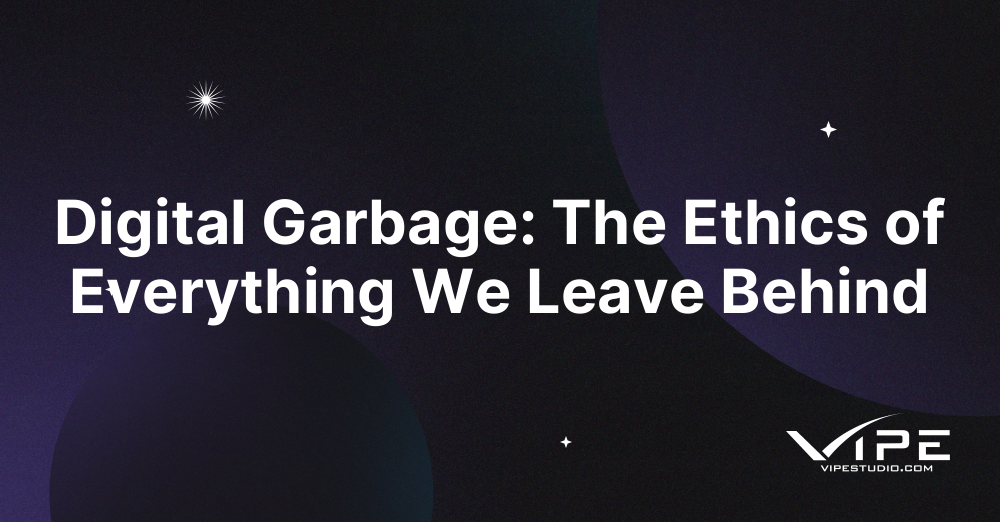15.10.2025
WordPress Development
Digital Garbage: The Ethics of Everything We Leave Behind
READING TIME: MIN
Table of Content
Introduction: The Overflow of the Digital Landfill
The internet is often celebrated as an infinite frontier of opportunity, creativity, and connectivity. Yet, beneath this promise lies an unspoken reality: the growing problem of digital garbage. From outdated websites and bloated plugins to poorly coded themes and abandoned projects, the web is increasingly cluttered with waste. This waste is not physical, but it has very real consequences – slowing down performance, damaging user trust, and polluting the overall digital experience. WordPress, as the most popular content management system in the world, sits at the center of this issue. Its accessibility empowers millions of creators, but it also generates unprecedented amounts of digital clutter when misused.
Defining Digital Garbage
What exactly is digital garbage? It’s not just obsolete websites left floating in cyberspace. It encompasses poorly optimized code, redundant plugins, spammy content, insecure installations, and abandoned digital assets that no longer serve their purpose. Just as physical garbage overwhelms landfills, digital waste accumulates in servers, domains, and databases across the globe. The effects are invisible to most users, but the inefficiencies ripple through the web’s infrastructure, consuming bandwidth, storage, and energy resources unnecessarily.
In the context of WordPress, digital garbage might include a site built with dozens of plugins where only a handful are actually used, images uploaded at massive file sizes without optimization, or half-finished themes sitting in the backend unused. These fragments accumulate, leading to slower performance and higher security risks.
How Poor WordPress Practices Contribute to the Problem
WordPress’s greatest strength – its openness – can also become its greatest weakness when approached without discipline. Many site owners fall into the trap of installing every new plugin they encounter, leaving old versions unmaintained, or relying on themes that are not optimized for modern performance standards. The result is a bloated site that drags down the user experience and becomes difficult to maintain over time.
Other contributors include:
- Abandoned installations: Sites set up for testing or experimentation and then forgotten.
- Duplicate content: Pages that offer little to no value, clogging search results and frustrating users.
- Outdated themes and plugins: Legacy software not only slows down sites but also opens doors to security vulnerabilities.
- Unoptimized media: Gigabytes of unnecessarily large images and video files stored without compression.
- Spam: Comment sections filled with irrelevant promotions and links that turn communities into wastelands.
The Cost of Digital Waste
Unlike physical garbage, digital waste does not take up visible space in our homes, but it carries hidden costs. Slow websites turn away users in seconds. Search engines penalize sites with thin or redundant content. Poorly maintained code creates security vulnerabilities that can lead to breaches. Hosting costs also increase as databases balloon with unused content and outdated assets. Perhaps most importantly, the overall quality of the internet suffers, making it harder for meaningful, well-crafted projects to stand out.
From an ecological perspective, digital waste also translates into higher energy consumption. Every unnecessary megabyte stored on a server consumes electricity. Multiply that by millions of websites, and the environmental impact becomes staggering.
Cleaning Up: The Role of Responsible WordPress Development
Just as cities organize waste management systems, the digital world requires intentional cleanup practices. WordPress offers all the tools needed to maintain efficiency, but they must be applied consistently. Regular audits, plugin management, and database optimization can transform a bloated site into a lean and high-performing platform.
Some best practices include:
- Performing regular site audits to identify unused plugins, themes, and content.
- Compressing images and using modern formats like WebP for efficiency.
- Implementing caching and content delivery networks (CDNs) to reduce server load.
- Keeping themes and plugins updated to prevent vulnerabilities.
- Removing duplicate or thin content that adds no value.
When Plugins Become Pollution
Plugins are the lifeblood of WordPress customization, but they are also one of the largest contributors to digital garbage. Many site owners install plugins to test features but never uninstall them. Some plugins overlap in functionality, while others are poorly coded, conflicting with the site’s core and slowing everything down. This clutter grows exponentially with time, especially in cases where multiple developers have worked on a site with different approaches.
The solution is not to avoid plugins but to be discerning. Every plugin should serve a specific, necessary function. Unused or redundant plugins should be eliminated. Periodic evaluations keep the plugin ecosystem within a site healthy and efficient.
Content as Waste or Value
Not all content is good content. In the race to rank on search engines, some site owners churn out low-quality, repetitive, or keyword-stuffed articles that provide little real value. This practice clutters the web with noise and makes it harder for meaningful voices to be heard. Content management is just as important as technical optimization when it comes to avoiding digital garbage.
WordPress enables effective content strategies by offering editorial workflows, SEO tools, and user-friendly publishing features. The challenge is using these tools wisely. A site that publishes fewer but higher-quality posts will often outperform one that floods the internet with filler material.
The Responsibility of Developers and Agencies
Developers and agencies play a pivotal role in reducing digital waste. A poorly built WordPress site delivered to a client can become a long-term burden, while a carefully crafted site sets the stage for sustainable growth. Clean code, scalable architecture, and thoughtful plugin use prevent problems before they arise. For organizations that lack in-house expertise, working with a professional WordPress agency ensures that sites are built for long-term efficiency rather than short-term fixes.
Examples of Digital Garbage in the Wild
Consider the countless abandoned blogs left untouched for years. They take up server space, consume energy, and add no value to users. Or think of e-commerce stores filled with duplicate product descriptions and broken links – confusing customers and hurting conversions. Even corporate websites, when left unchecked, often accumulate years of unused images, outdated press releases, and redundant landing pages that bog down their performance.
On the flip side, businesses that invest in cleanup see dramatic improvements. Streamlined websites load faster, rank higher, and deliver a better user experience. Clients who once struggled with slow, clunky platforms often report newfound efficiency and customer satisfaction once the digital garbage is removed.
Preventing Future Piles of Digital Waste
Cleanup is only one half of the equation. The other half is prevention. This means building sites with sustainability in mind. Lightweight themes, minimal reliance on plugins, efficient hosting, and clear content strategies all help prevent the accumulation of unnecessary clutter. Prevention is cheaper, easier, and more effective than endless cycles of cleanup.
For businesses that want to scale responsibly, it often makes sense to partner with WordPress experts who prioritize sustainability from day one. Such collaboration ensures that websites remain lean, secure, and impactful well into the future.
Conclusion: Toward a Cleaner Web
Digital garbage may be invisible, but its effects are undeniable. Bloated, neglected, and poorly managed websites slow down the web, frustrate users, and waste valuable resources. WordPress offers unparalleled opportunities for creation, but with that comes responsibility. Through mindful design, disciplined content management, and sustainable development practices, site owners and developers can help clean up the digital landfill and build a web that is faster, safer, and more meaningful. The challenge is not merely technical but cultural: shifting from careless creation to intentional stewardship. In doing so, we turn the tide from pollution to progress.
Key Takeaways
- Digital garbage includes outdated code, unused plugins, spam, and low-value content.
- Poor WordPress practices often accelerate the buildup of waste on the web.
- Cleanup strategies include audits, optimization, and responsible plugin use.
- Content should add value rather than clutter search results.
- Developers and agencies have a duty to build sustainable WordPress sites.
- Prevention is better than cure – sustainability must be baked into site design.
More on The Topic
- WordPress 6.9 “Gene”: What This Release Really Changes
- Managing Gutenberg Chaos at Scale
- The Real Difference Between Managed and Developer-Oriented Hosting
- WordCamp Sofia 2025: A Full Recap of Bulgaria’s Biggest WordPress Event
- Why Multilingual Sites Thrive on WordPress
The content of this website is copyrighted and protected by Creative Commons 4.0.



